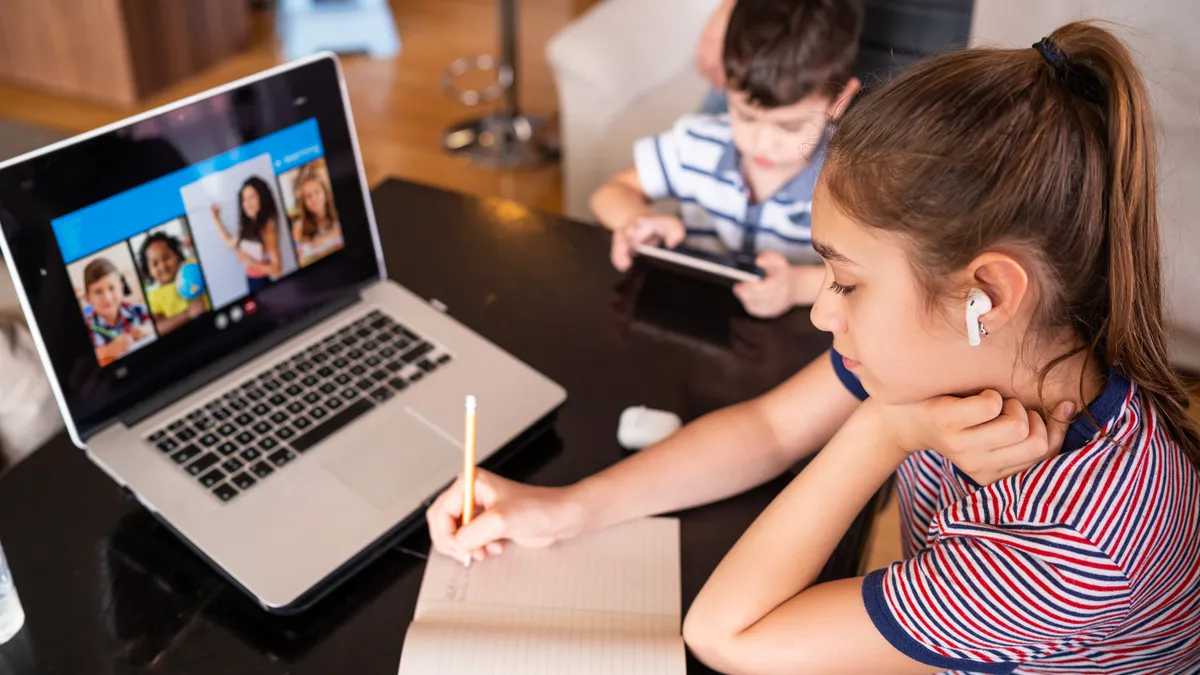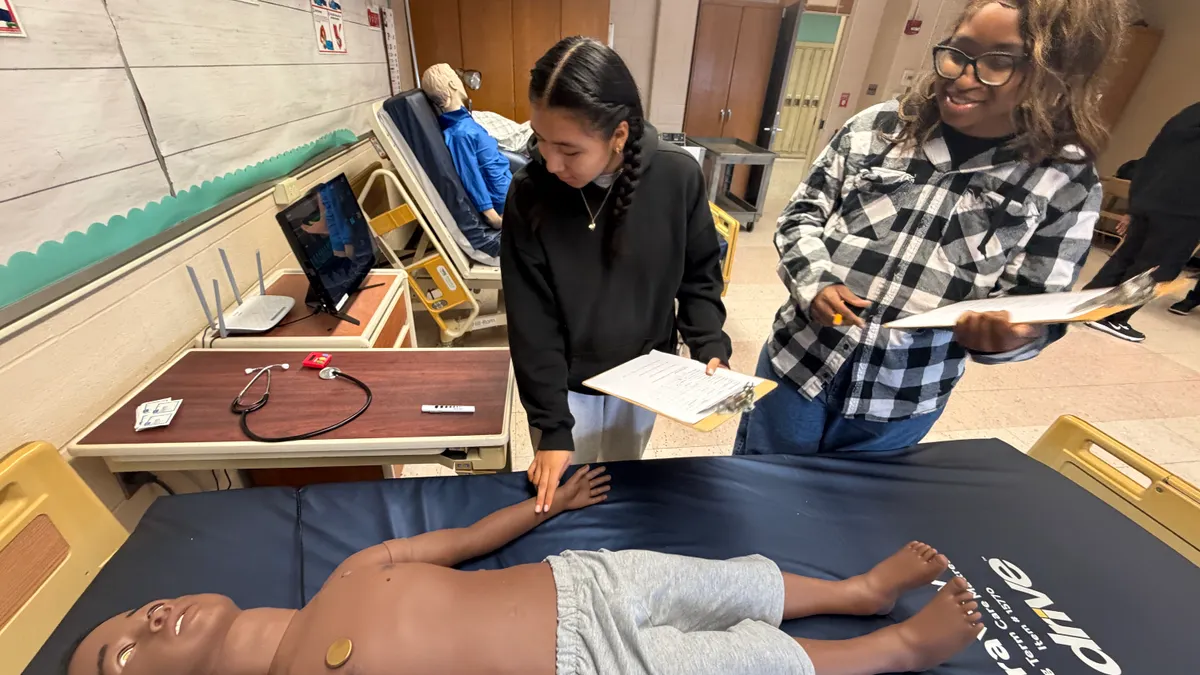To ensure learning continued amid coronavirus-related school shutdowns that began in spring, districts built in a fair bit of flexibility around not just where learning could take place, but when. While there were some synchronous learning opportunities, "the bulk of the day was perhaps spent with students simply doing an activity, doing the assignment, and then turning it back in to their teachers," said Clay Hunter, interim associate superintendent of curriculum and instructional support for Georgia's Gwinnett County Public Schools.
This was due in part not just to the disrupted daily schedules of students and educators, but also to allow lesson plans to be assembled in a way that educators could quickly and efficiently begin teaching online. But it was far from perfect.
"We learned from parents that while they were grateful we continued the learning throughout the spring, they were frustrated with all of the questions their children had, and wanted and needed that teacher to be there with them through that entire journey," Hunter said.
Now, while digital learning has been rethought for the fall to provide synchronous opportunities for students who are both physically in class and attending digitally, the challenge is providing the same level of attention to all. Over the course of our conversation, Hunter detailed how his district is addressing these challenges, parent frustrations, social-emotional learning and more.
EDUCATION DIVE: When it comes to that parent frustration, how much more important during this time period has it been to make sure there's really strong parent-teacher communication?
CLAY HUNTER: Extremely important. Let's go a little bit further: Parents now — especially our digital parents — have to know, “Well, what time should we be logged on?” The most important time for parents used to be, “What time do I need to get you to the bus stop? Or what time do I need to drop you off?”
Let's go with a drop-you-off scenario. “What time do I need to be in the line? And what time will the doors open so you can get out of the car and go about your day?” Now, parents and teachers have to be on the same page around what time will the Zoom session start where the synchronous learning is going to take place, when will their child then be charged with doing their work independently, and when will breaks be allowed.
And when is a good time for [the parent] to email the teacher and ask questions and get support? In other words, when can we do office hours? I'm now going back to March because we didn't have those structures formally in place. We had teachers who were taking those phone calls at 10 or 11 at night, right? They were getting texts throughout the day.
My point, simply, is now that we have a traditional model school day layered on top of a digital platform for those digital parents in particular, we have to make sure we walk them through that day in a way we've never had to do before.
The thing I've seen across the board with people I've talked to since March is that there's a much more hands-on role now for parents than previously.
Much more hands-on. In March, that was intense because, again, when students had that independent assignment they had to turn in by a certain day, they were relying on parents to a greater degree.
Now, we've tried to sort of lift that load from parents, but I would imagine there are moments where even if the teacher is available, the child still feels more comfortable turning to mom or dad and saying, “Hey, my teacher is working with another group of students. I have a quick question. Can you answer that for me?”
But is that absolutely as necessary as it was perhaps in March? No. Because teachers have structures in place where they are moving students in and out of conferencing opportunities with them in order to provide that support.
Do you find there's also, on the parents’ side, a greater appreciation for what educators are doing every day?
Absolutely. Everything from the behavioral management skills we've put in place, [to situations] where the child who may act one way at home magically knows what to do, when to do it, how to do it when they are in school.
You know, when you think about the first 20 days and the research around structures in learning, what our teachers are masters at is helping students understand routine and building those routines into the learning. That’s one of the biggest things parents have applauded is our ability to set routines and help their children understand those routines and abide by them.
The second thing is our ability to intervene. [With] the intervention strategies we have at our disposal, parents have a sense of what their children know and don't know, what their children struggle with. What we're seeing and hearing is parents are amazed at a teacher's ability to unpack those misconceptions students have and help them make bridges between what the child knows and doesn't know.
What are some of the biggest lessons you've learned from spring as you moved into the fall and into a model where students have the option of in-person or online?
I'm going to put it like this: The biggest opportunity is our ability to maximize technology in order to meet the needs of all students. This is where, while it's unfortunate that we are facing COVID, a crisis has led to some great opportunities.
Let me give you an example. There are digital tools that have existed for some time. Nearpod and Desmos are two I'm going to use for the purpose of this example. You have these digital tools, and parallel to these digital tools, research has been quite clear on the things you need to do in order to make sure you have an effective lesson.
You need an activating strategy to help students with prior knowledge versus the knowledge they're about to acquire. You need a mini-lesson where you can model for the students what you expect for them to know and be able to do. You need an opportunity for those students to be able to collaborate with both the teacher and their peers to deepen their understanding.
It's in that collaboration that you do a formative assessment to see how well students know what has just been taught, because you use that formative assessment in order to do small group instruction. That's the natural flow of the learning.
So you take software like Nearpod or Desmos, and there are actually applications inside of the software that help you enhance that learning: There's the video that you can now do. And during your mini-lesson, students can play it over and over again if they were confused about the modeling. They may not have had the opportunity for that video in a traditional setting before COVID, you know? You kind of had to catch that mini-lesson right then and there.
Now it's video, and you can replay it as many times as you need to, to watch the teacher do that math problem or analyze that text when it's time for there to be formative assessment, instead of students raising their hands where you have some children who are scared to raise their hand and some students who are overly eager and they talk too much.
Now, there's this equity and voice because students can actually click a button and answer very quick, and the teacher can see who answered it correctly or incorrectly and help them with their misconception, without any other child knowing, saving that child from embarrassment and encouraging them to take the risk to say, “Hey, I don't know.” They can send it in a chat box directly to the teacher.
With some students learning in person and some still learning online, what have been some of the challenges of setting it up so they're learning synchronously?
Let's give one example using a model called concurrent instruction. That's where I’m one teacher in the classroom, I have students who are digital and in-person, and I need to teach them simultaneously. The challenge of attempting to do all of that means I won't go back through that whole lesson.
That’s the challenge of having to move from Zoom to students' desks, the challenge of having to have students raise their hand in class and respond to the hands being raised online — having to toggle back and forth between those students, meeting all of their needs simultaneously. And also the parent that may sort of jump in and have their two cents to say and want to ask the question right in the middle of the classroom. All of those things, teachers have to juggle simultaneously.
That becomes a challenge. If you don't want to do that concurrent model and you want to do something we call teaming — where a teacher takes on all the children who are in person and another takes on all the children who are digital — now you've got to really rethink your entire schedule, right? Let's say we have 50 students between the two of us, and 40 of them want to be digital and 10 want to be in-person. I'm trying to balance the fact that I only have 10 students that I'm teaching in person, you’ve got 40 digitally, and that becomes a problem.
So you have to really think long and hard about the schedule relative to the learning preferences of the parents and students. Those are some of the dilemmas we face.
And on a content front?
Social-emotional learning of our students and our parents and our teachers is now more important. We've got to take time during the day, during collaborative planning, during faculty meetings, etc., to really give our teachers an opportunity to really share with us where they are socially and emotionally.
By that same token, equally important is making sure during the learning day, we provide opportunities for children to check in with us — not just, “Hey, do you know this math equation?” But first and foremost, “How are you doing? What's going on with you? How are you feeling? How's your family?” What can we do in order to make sure that we support each other in order to meet the social and emotional needs of our students?
On the social-emotional front, as well, how much more important has that become in recent months, given the civil rights issues that have come to the forefront?
You're hitting the nail on the head, which is if COVID wasn't enough, we have the very important conversations that we need to be having around social justice, equity and making sure we all have that equal opportunity to live out our founding fathers’ dreams and aspirations. So we need that space, as well.
That, again, is tied to the social-emotional, and really it's about giving students an opportunity to talk about how they feel and what they feel, and allowing them to get that out and put that on the table. Making sure the teacher is aware of what's burdening that student, making sure students know and are aware of where the teacher is. It’s very, very difficult for you to move into that instruction if there isn't a sense of trust and community that entire class has.




















